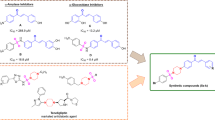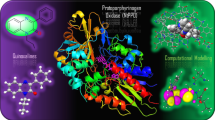Abstract
New analogues of nifedipine, in which the ortho-nitro phenyl group at position 4 has been replaced by 4(5)-chloro-5(4)-imidazolyl substituent and which are able to interact with the receptor by hydrogen binding were designed, synthesized, and evaluated as calcium channel antagonists. The designed dihydropyridines were synthesized using the Hantzsch condensation and evaluated as calcium channel antagonists using the high K+ contraction of guineapig ileal longitudinal smooth muscle. A docking study was performed using the AutoDock4 program, and QSAR equations were obtained using multilinear regression. Our computational studies indicated that the oxygen of the ester (O10) and the N3′ of the imidazole ring form a hydrogen bonding interaction with the NH of HIS 363 and NH of LYS354, respectively, and that the sum of the BEHp5 and RDF075p are the most significant descriptors. The results of calcium channel antagonist evaluation demonstrated that increasing the chain length in C3 and C5 ester substituents increased activity. The most potent compound was the bis-phenylpropyl ester (5l) derivative, in that it was more active than the reference drug nifedipine and that the bis-phenylethyl ester (5k) derivative had comparable activity with nifedipine. The present research revealed that the 4(5)-chloro-5(4)-imidazolyl moiety is a bioisoster of o-nitrophenyl in nifedipine and provided novel dihydropyridines with more activity as calcium channel antagonists.
Similar content being viewed by others
References
Arrowsmith, J. E., Campbell, S. F., Cross, P. E., Stubbs, J. K., Burges, R. A., Gardiner, D. G., and Blackburn, K. J., Long-acting dihydropyridine calcium antagonists. 1. 2-Alkoxymethyl derivatives incorporating basic substituents. J. Med. Chem., 29, 1696–1702 (1986).
Bolger, G. T., Gengo, P., Klockowski, R., Luchowski, E., Siegel, H., Janis, R. A., Triggle, A. M., and Triggle, D. J., Characterization of binding of the Ca++ channel antagonist, [3H]nitrendipine, to guinea-pig ileal smooth muscle. J. Pharmacol. Exp. Ther., 225, 291–309 (1983).
Coburn, R. A., Wierzba, M., Suto, M. J., Solo, A. J., Triggle, A. M., and Triggle, D. J., 1,4-Dihydropyridine antagonist activities at the calcium channel: a quantitative structureactivity relationship approach. J. Med. Chem., 31, 2103–2107 (1988).
Davood, A., Khodarahmi, G., Alipour, E., Dehpour, K., Amini, M., and Shafiee, A., Synthesis and calcium channel antagonist activity of nifedipine analogues containing 4(5)-chloro-2-methyl-5(4)-imidazolyl substituent. Boll. Chim. Farm., 140, 381–386 (2001).
Davood, A., Mansouri, N., Rerza Dehpour, A., Shafaroudi, H., Alipour, E., and Shafiee, A., Design, synthesis, and calcium channel antagonist activity of new 1,4-dihydropyridines containing 4-(5)-chloro-2-ethyl-5-(4)-imidazolyl substituent. Arch. Pharm (Weinheim)., 339, 299–304 (2006).
Davood, A., Nematollahi, A. R., Iman, M., and Shafiee, A., Synthesis and docking studies of new 1,4-dihydropyridines containing 4-(5)-Chloro-2-ethyl-5-(4)-imidazolyl substituent as novel calcium channel agonist. Arch. Pharm. Res., 32, 481–487 (2009).
Davood, A., Nematollahi, A., Iman, M., and Shafiee, A., Computational studies of new 1,4-dihydropyridines containing 4-(5)-chloro-2-ethyl-5-(4)-imidazolyl substituent: QSAR and docking. Med. Chem. Res., 19, 58–70 (2010).
Fleckenstein, A., Specific pharmacology of calcium in myocardium, cardiac pacemakers, and vascular smooth muscle. Annu. Rev. Pharmacol. Toxicol., 17, 149–166 (1977).
Gaudio, A. C., Korolkovas, A., and Takahata, Y., Quantitative structure-activity relationships for 1,4-dihydropyridine calcium channel antagonists (nifedipine analogues): a quantum chemical/classical approach. J. Pharm. Sci., 83, 1110–1115 (1994).
Godfraind, T., Calcium entry blockade and excitation contraction coupling in the cardiovascular system (with an attempt of pharmacological classification). Acta Pharmacol. Toxicol (Copenh)., 58Suppl 2, 5–30 (1986).
Goldmann, S. and Stoltefuss, J., 1,4-Dihydropyridines: effects of chirality and conformation on the calcium antagonist and calcium agonist activities. Angew. Chem. Int. Ed. Engl., 30, 1559–1578 (1991).
Hansch, C., A quantitative approach to biochemical structure-activity relation-ships. Acc. Chem. Res., 2, 232–239 (1969).
Hansch, C. and Fujita, T., A method for the correlation of biological activity and chemical structure. J. Am. Chem. Soc., 86, 1616–1626 (1964).
Hantzsch, A., Ueber die Synthese Pyridinartiger Verbindungen aus Acetessigather und Aldehydammoniak. Justus Liebigs Ann. Chem., 215, 1–82 (1882).
Huey, R. and Morris, G. M., Using AutoDock 4 with Auto-DockTools, (2007).
Janis, R. A. and Triggle, D. J., New developments in Ca2+ channel antagonists. J. Med. Chem., 26, 775–785 (1983).
Li, A. H., Moro, S., Melman, N., Ji, X. D., and Jacobson, K. A., Structure-activity relationships and molecular modeling of 3, 5-diacyl-2,4-dialkylpyridine derivatives as selective A3 adenosine receptor antagonists. J. Med. Chem., 41, 3186–3201 (1998).
Pourmorad, F., Hadizadeh, F., and Shafiee, A., Synthesis and calcium channel activity of 4-imidazolyl-1,4-dihydropyridines. Pharm. Sci., 3, 165–168 (1997).
Rovnyak, G. C., Atwal, K. S., Hedberg, A., Kimball, S. D., Moreland, S., Gougoutas, J. Z., O’Reilly, B. C., Schwartz, J., and Malley, M. F., Dihydropyrimidine calcium channel blockers. 4. Basic 3-substituted-4-aryl-1,4-dihydropyrimidine-5-carboxylic acid esters. Potent antihypertensive agents. J. Med. Chem., 35, 3254–3263 (1992).
Schramm, M., Thomas, G., Towart, R., and Franckowiak, G., Novel dihydropyridines with positive inotropic action through activation of Ca2+ channels. Nature, 303, 535–537 (1983).
Shafiee, A., Dehpour, A. R., Hadizadeh, F., and Azimi, M., Syntheses and calcium channel antagonist activity of nifedipine analogues with methylsulfonylimidazolyl substituent. Pharm. Acta Helv., 73, 75–79 (1998).
Shafiee, A., Rastkary, N., and Jorjani, M., Synthesis and calcium channel antagonist activity of 1,4-dihydropyridine derivatives containing 4-nitroimidazolyl substituents. Arzneimittelforschung, 52, 537–542 (2002).
Author information
Authors and Affiliations
Corresponding author
Rights and permissions
About this article
Cite this article
Iman, M., Davood, A., Nematollahi, A.R. et al. Design and synthesis of new 1,4-dihydropyridines containing 4(5)-chloro-5(4)-imidazolyl substituent as a novel calcium channel blocker. Arch. Pharm. Res. 34, 1417–1426 (2011). https://doi.org/10.1007/s12272-011-0902-9
Received:
Revised:
Published:
Issue Date:
DOI: https://doi.org/10.1007/s12272-011-0902-9




